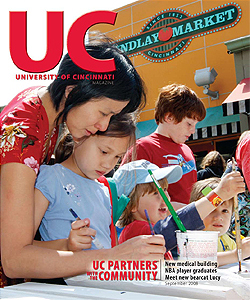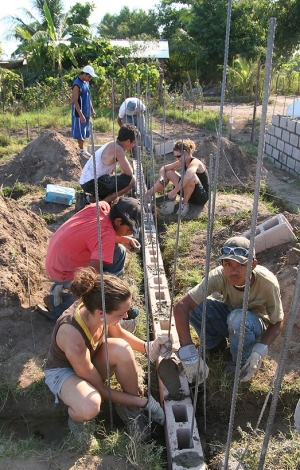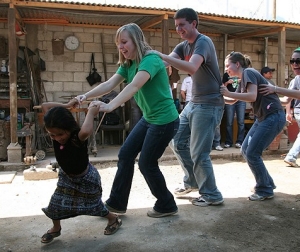Creating community connections
At first glance, the UC students assumed the dilapidated shacks -- houses made of scrap wood and tarps -- were uninhabitable. But close inspection revealed entire families cooking and sleeping in the "homes" in a neighborhood outside the northeastern Mexican city of Saltillo.
For three families, that was about to change as 15 students built three houses in one week during spring break 2006. "It was a powerful experience," says Micah Whitt, a fifth-year engineering student and former president of the student group Serve Beyond Cincinnati. "People were excited. We came back and asked, 'Where do we go next?'"
Where they went next was around the world and back again, building safe homes for those in need along the way. During the 2007-08 academic year, the group organized three fall weekend trips to Appalachian Kentucky; three winter-break trips to Alabama, New Orleans and El Salvador; and four spring-break trips to Guatemala, Mexico and northern Louisiana. Plus, members volunteered at local soup kitchens and homeless shelters.
More than 100 UC students participated in 2007, Whitt says, a far cry from the initial 15. "After each trip, more and more people want to be involved.
"We're building an army of volunteers. I've seen people go on these service trips and have their lives change. They see how the world is and want to figure out how to use their skills to help people."
The origins of Serve Beyond Cincinnati and its projects are well-known at the Center for Community Engagement, a decade-old initiative that acts as a springboard for many of the university's philanthropic ideas and a network where UC volunteers -- students, faculty and staff -- connect with local nonprofits.
Kathy Dick, SSW '74, director of the center for the last three years, says most projects or community partnerships tend to be student-initiated, with staff providing guidance until the project can really stand on its own.
One that has certainly found its footing is UC's Relay For Life, a massive 18-hour campus event that this year involved more than 2,000 student volunteers, many of them camping out on McMicken Commons while waiting to walk or run the track to raise money for the American Cancer Society. UC's relay teams raised more than any Ohio campus this year, accumulating a five-year total of more than $400,000.
Five years ago was also the beginning of another key partnership. That's when Annie Fitzgerald, A&S '05, returned from a Habitat for Humanity project determined to see the university get involved in a major way. "She came back to the university and said, 'With all of our resources, talents and gifts, UC should be building a Habitat house every single year,'" says Dick. "Be-fore long, there was a whole infrastructure -- a steering committee, funds and student recruits." By the end of the next year, they had built a house, which they repeated the next year, and the next. In all, UC has built five homes for needy families.
"We all learned so much, not only skills for building a house, but also how to build a community," Fitzgerald says of her first Habitat project. "I wanted the students at UC to have this same experience." She returned to Cincinnati and talked with William Harris, A&S '92, then director of the Center for Community Engagement. With Harris' encouragement, Fitzgerald contacted Cincinnati Habitat and began working on raising the money needed to build a house. Fitzgerald even organized students, drove them to and from the site and transported their food.
"William was instrumental in getting the UC community behind the project," Fitzgerald says. "The Center for Community Engagement supported the project from the beginning and allowed me to use their resources to make it happen."
Next, the university will partner with the nonprofit on a special project to build houses for families in which at least one person is disabled. Students involved with UC's Community Design Center participated in a competition to design the homes and the city of Cincinnati provided needed infrastructure improvements on the property.
UC students interested in service can even live with others who share their passion and commitment now. The Center for Community Engagement has a community-service "theme house" at Stratford Heights, an apartment-style student residence complex across from UC's West Campus on Clifton Avenue. The center decided to move its offices into the house, as well, which has 26 beds for residents and includes meeting space for student groups such as Serve Beyond Cincinnati.
"The house filled quickly because students liked the idea of a theme house," Dick says. "Some of them moved in because they wanted to do service, and some just wanted to be with students who were service-minded."
Students, however, are not the only university members anxious to serve. With the center's help, more and more faculty are now implementing service learning into their courses.
"In essence, service learning is coursework that incorporates meaningful experience in the community as an integral part of a student's learning process in a class," says Mary Stagaman, UC's associate vice president of external relations and executive director of Center for the City. "It is more than a field trip or a few hours spent with community members. It provides a rich, real-life experience that uses community interaction to deepen the student's understanding of a subject."
To help faculty identify service-learning opportunities, the Center for Community Engagement holds a faculty-community partnership breakfast twice a quarter where professors and local nonprofits discuss possibilities for collaborative projects.
In 2007, UC journalism professor Elissa Sonnenberg, A&S '88, worked with the center to help implement a partnership between the National Underground Railroad Freedom Center and two courses focusing on the role of the black press in U.S. history. Through funding provided by the Center for Community Engagement, students were able to conduct field research in Chicago and Pittsburgh to collect audio, video and photography for an interactive Web site created as part of the project.
UC students worked directly with the Freedom Center and held a public forum to present their work. In addition, students from Withrow, Turpin and Lakota high schools attended UC student presentations on campus and during the forum. One high school journalist wrote a front-page article on the project for the Cincinnati Herald newspaper. "None of that would have been possible without Kathy Dick and her team," Sonnenberg says. "I'm so proud of the students and what they accomplished."
To promote even more partnerships, the center recently received an Ohio Campus Compact grant, providing $4,000 each to four different faculty members who will add service-learning components to their courses. One class in the School of Social Work, for instance, worked with administrators at Accountability and Credibility Training, or ACT, a relatively new organization that provides alternatives to welfare and government assistance.
Dick believes the center's liaison role between faculty and the community benefits nonprofits in a distinct way by pushing them to make creative use of the resources being offered, encouraging them to use students to do more than sit behind a reception desk or sort items at a food pantry. "When you're in a nonprofit and resources are getting tighter, it's nice to know there is additional help available. We provide research, talent and physical support, whether we're renovating a building or beautifying a park."
Sometimes, that type of creative thinking can lead to extraordinary results that impact not just the local community, but also the world. Micah Whitt and Serve Beyond Cincinnati are currently preparing for the group's largest endeavor yet: Hope Life Water, a mission to bring a clean water system to two remote villages in Cameroon, Africa. Two digital media students from UC plan to work with Whitt to produce a documentary of the 18-day trip, which will take a small contingent of volunteers to the continent over winter break of December 2008.
And for the ambitious Whitt, the lessons don't stop there. He says the leadership role he's played with Serve Beyond Cincinnati has left him with plans to pursue nonprofit administration after graduation. He believes participation in volunteer experiences has long-lasting impact on his peers at UC, as well.
"People's eyes open to how they should or could be living when they see how others live," Whitt says. "College is a crossroads. You decide if you're going to be for yourself or make the world a better place."

 Issue Archive
Issue Archive
